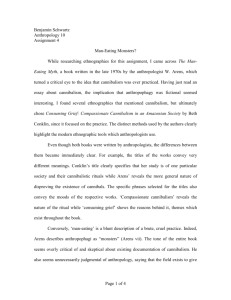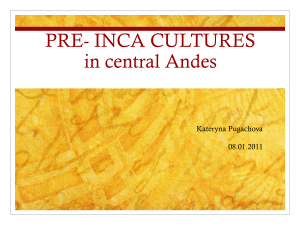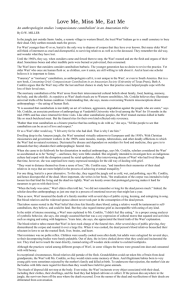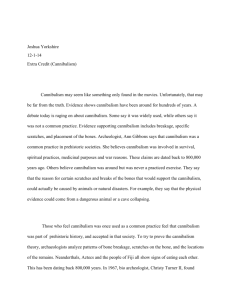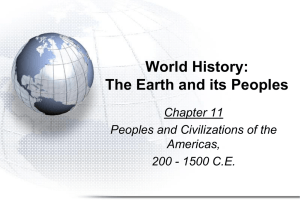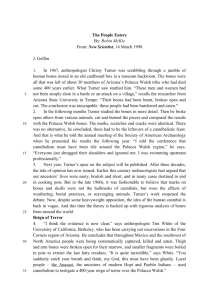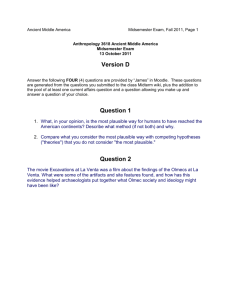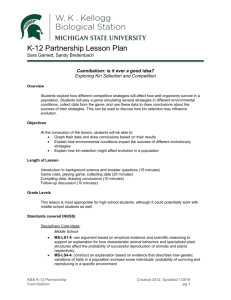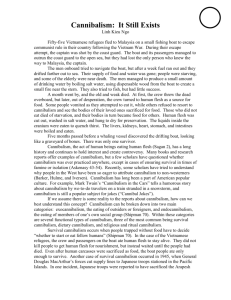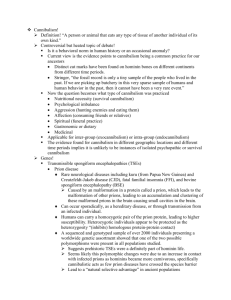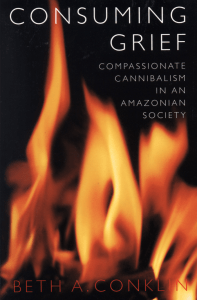doc
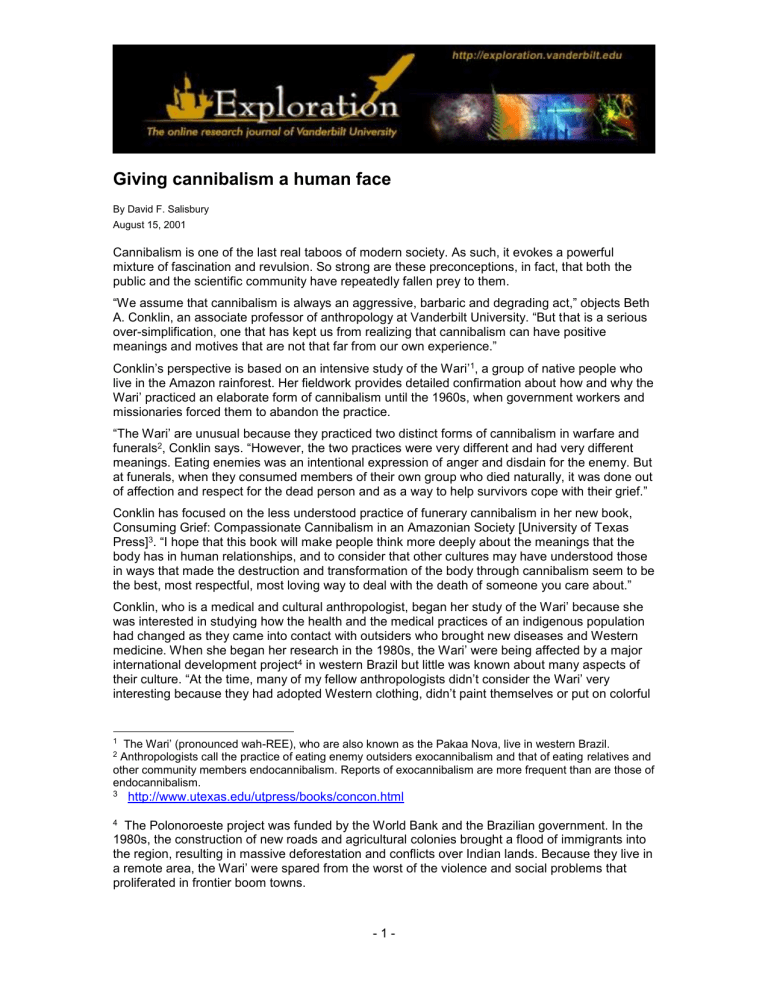
Giving cannibalism a human face
By David F. Salisbury
August 15, 2001
Cannibalism is one of the last real taboos of modern society. As such, it evokes a powerful mixture of fascination and revulsion. So strong are these preconceptions, in fact, that both the public and the scientific community have repeatedly fallen prey to them.
“We assume that cannibalism is always an aggressive, barbaric and degrading act,” objects Beth
A. Conklin, an associate professor of anthropology at Vanderbilt University. “But that is a serious over-simplification, one that has kept us from realizing that cannibalism can have positive meanings and motives that are not that far from our own experience.”
Conklin’s perspective is based on an intensive study of the Wari’ 1 , a group of native people who live in the Amazon rainforest. Her fieldwork provides detailed confirmation about how and why the
Wari’ practiced an elaborate form of cannibalism until the 1960s, when government workers and missionaries forced them to abandon the practice.
“The Wari’ are unusual because they practiced two distinct forms of cannibalism in warfare and funerals 2 , Conklin says. “However, the two practices were very different and had very different meanings. Eating enemies was an intentional expression of anger and disdain for the enemy. But at funerals, when they consumed members of their own group who died naturally, it was done out of affection and respect for the dead person and as a way to help survivors cope with their grief.”
Conklin has focused on the less understood practice of funerary cannibalism in her new book,
Consuming Grief: Compassionate Cannibalism in an Amazonian Society [University of Texas
Press] 3 . “I hope that this book will make people think more deeply about the meanings that the body has in human relationships, and to consider that other cultures may have understood those in ways that made the destruction and transformation of the body through cannibalism seem to be the best, most respectful, most loving way to deal with the death of someone you care about.”
Conklin, who is a medical and cultural anthropologist, began her study of the Wari’ because she was interested in studying how the health and the medical practices of an indigenous population had changed as they came into contact with outsiders who brought new diseases and Western medicine. When she began her research in the 1980s, the Wari’ were being affected by a major international development project 4 in western Brazil but little was known about many aspects of their culture. “At the time, many of my fellow anthropologists didn’t consider the Wari’ very interesting because they had adopted Western clothing, didn’t paint themselves or put on colorful
1 The Wari’ (pronounced wah-REE), who are also known as the Pakaa Nova, live in western Brazil.
2 Anthropologists call the practice of eating enemy outsiders exocannibalism and that of eating relatives and other community members endocannibalism. Reports of exocannibalism are more frequent than are those of endocannibalism.
3 http://www.utexas.edu/utpress/books/concon.html
4 The Polonoroeste project was funded by the World Bank and the Brazilian government. In the
1980s, the construction of new roads and agricultural colonies brought a flood of immigrants into the region, resulting in massive deforestation and conflicts over Indian lands. Because they live in a remote area, the Wari’ were spared from the worst of the violence and social problems that proliferated in frontier boom towns.
- 1 -
Giving cannibalism a human face native ceremonies very often and were generally considered to be under the thumb of the missionaries,” Conklin says.
From 1985 to 1987, the anthropologist spent 19 months living in Wari’ communities, plus seven months collecting data at an indigenous health clinic and in national archives. Return trips in
1991, 1999 and 2000 allowed her to confirm her information and interpretations. The case for
Wari’ cannibalism is based on the testimony of the Wari’ themselves, corroborated by accounts of missionaries and government officials who said they had witnessed cannibalism at Wari’ funerals in the 1950s and 1960s 5 . Conklin interviewed dozens of older Wari’ who remembered life before contact and talked freely about observing and participating in funerals in which cannibalism was practiced. At about the same time, two Brazilian scientists 6 conducted independent research among the Wari’, producing findings that closely correspond with Conklin’s.
“When I decided to study the Wari’ I was a vegetarian and the last thing I was interested in studying was cannibalism,” Conklin recalls. Her attitude changed as she talked to Wari’ about their experiences with the deaths of family members. To assess changes in patterns of illness and death, Conklin interviewed the heads of 198 Wari’ families and compiled information about when and how their relatives died. Her research documented a history of brutal assaults on the
Wari’. Before contact, the Wari’ lived in almost total isolation from other people. They knew of the existence of other Indians and nonIndians, but considered them as “wijam” (outsiders, enemies).
They did not trade or intermarry or have peaceful relations with wijam. Their only interactions with outsiders were hostile.
In the 1950s, local businessmen who wanted to open Wari’ lands to commercial development hired assassins, armed them with machine guns and repeating rifles, and sent them out to kill the natives. Whereas Wari’ warriors killed intruders one by one, the assassins massacred entire villages, including many women and children. As a result, more than 25 percent of the deaths that t he Wari’ suffered were the result of killings by Brazilians. To stop the escalating violence, the government stepped in.
First in 1956 and then in 196162, “pacification teams” went into the forest to leave gifts to attract the Wari’ into peaceful contact. The friendly contact proved to be even more devastating to the
Wari’ than the previous hostilities. Due largely to ignorance and carelessness on the part of the government workers, the Wari’ were exposed to infectious diseases to which they had little resistance. The missionaries were much more careful and did what they could to save lives.
Nevertheless, the Wari’ died in large numbers and their total population shrank from about 1,000 to 399 within a few years, Conklin says. During the devastating epidem ics, the Wari’ became dependent on the government and missionaries for food and medicine. The outsiders used their influence to put a stop to cannibalism and make the Wari’ adopt Western burial practices. Today, all bodies are buried. As Conklin collected family histories of the Wari’, the process led inevitably to the subject of funeral practices. In discussions with older people, she learned that some were uncomfortable with the practice of burial, considering it to be a less respectful and less comforting way to treat the passing of someone you care about.
“In the past, the idea of leaving the body of a loved one in the dirt and letting it rot was as repulsive to the Wari’ as the idea of eating human flesh is to us,” Conklin explains.
7
5 Conklin acknowledges that no anthropologists, including herself, have witnessed a case of Wari’ cannibalism, but considers the testimony that she and fellow anthropologists have collected create an extremely compelling case that the Wari’ formally practiced a socially sanctioned form of cannibalism. “I have never met nor heard of any Wari’ who denied it and, as far as I know, every ethnographer, linguist, missionary and priest who has worked with the Wari’ has been convinced that they really did eat their dead,” she says.
6 Aparecida Vilaça, an ethnographer from the National Museum in Rio de Janeiro, and Denise Meireles, an anthropologist and ethnohistorian from the University of Brasilia.
7 “These are people who really pay a lot of attention to cleanliness and hygiene. They love fresh smells, good smelling flowers and leaves and perfumes,” Conklin says.
- 2 -
Giving cannibalism a human face
As she began exploring these attitudes, Conklin found that the models developed by anthropologists and psychologists to explain cannibalism did not fit. The Wari’ did not eat human flesh because they needed the protein. They were not trying to absorb the dead person’s life force, courage or other qualities. They were not acting out aggression, dominance or a desire to hold onto the deceased. Instead, Conklin concluded that the practice was deeply rooted in the world view of the Wari’ and their understanding of how memories affect the grieving process. Like a number of other groups in South America, the Wari’ have rituals designed to help bereaved relatives cope with their sorrow by eliminating things associated with the dead, which provoke sadness by reminding survivors of t heir loss and also may attract the dead person’s ghost. To loosen attachments between the living and the dead, Wari’ burn all the dead person’s possessions, including the house he or she lived in. They stop speaking the person’s name and change the appearance of the village and other places where the dead person spent time.
“Consuming the body is part of this process as well,” Conklin says. “Far more than we do, the
Wari’ see the body as a place where personality and individuality reside, and so, of all the things that remind you of dead people, the corpse is the strongest reminder. So they believed it was important to transform the corpse in order to help transform survivors’ memories of their dead relative.” This transformation involves developing new images of the dead person joining the animal world. According to their traditional beliefs, the spirits of dead relatives go to an underground world from which they return in the form of wild, pig-like animals called peccaries that are a major source of meat for the Wari’. The ancestor-peccaries seek out hunters from their own families and offer themselves to be shot, ensuring that their meat will go to feed the people they love.
This special relationship with peccaries is part of a native cosmology centered on ideas about communication and transformations between humans and animals. According to Conklin, the traditional mourning rites of the Wari’ emphasized helping survivors to gradually stop dwelling on memories of the past and develop new images of the dead rejuvenated as animals who feed the living. Eating the body at funerals affirmed these positive religious ideas. Reconsidering the range of meanings that consuming substances from the human body had for people in the past is important, Conklin says, because it challenges the negative stereotypes of cannibalism that have often been used to denigrate and stigmatize native peoples. “Thinking about cannibalism as a way to cope with grief and mourning gives it a more human —even humane—face,” Conklin says.
Such reconsideration can also make us reflect on our own ways of dealing with death.
“Wari’ recognize the intensity of bereavement, whereas the tendency these days is to resist even the thought of death. In modern society, there is no longer a standard way of dealing with death and I think something has been lost. As a result, we are very uncomfortable dealing with bereavement,” Conklin says.
8 “We feel pressure to hide our grief; we don’t know how to treat people who have suffered a loss. There is a certain wi sdom in the Wari’ practice of acknowledging the deep impact of death and survivors’ need for social and spiritual support.” To us, cannibalism looks like an extreme, exotic practice. “By stepping outside our own cultural framework to try to understand this from the Wari’ point of view, however, we can see some of the realities of social life, especially the ways of caring and coping, that unite us all as human beings,” she says.
-VU-
ADDITIONAL INFORMATION:
University of Texas Press http://www.utexas.edu/utpress/books/concon.html
General information about the Wari', on the website of the Instituto Socioambiental, the major indigenous rights organization based in Brazil. (in Portuguese) http://www.socioambiental.org/website/epi/wari/wari.htm
8 “My own brother died while I was working through this material. The concerns that Wari’ have about grief and the rituals that they have developed to help people cope with bereavement helped me understand my own grief better,” Conklin says.
- 3 -
Giving cannibalism a human face
Announcement of the discovery of a previously unknown sound identified in the Wari' language by linguist Daniel Everett,. http://www.emich.edu/~linguist/issues/5/5-997.html#1
Brief history of cannibal controversies
“Cannibalism is a difficult topic for an anthropologist to write about, for it pushes the limits of cultural relativism, challenging one to define what is or is not beyond the pale of acceptable human behavior,” writes Beth Conklin in her new book, Consuming Grief: Compassionate
Cannibalism in an Amazonian Society [University of Texas Press].
Historically, charges of cannibalism were used by European nations to help justify their colonization efforts. As a result, many historical allegations of people eating are undoubtedly false. But the fact that such allegations were made is not sufficient grounds to conclude that all reports of cannibalism are untrustworthy and should be discounted, Conklin says.
During the 15 th , 16 th and 17 th centuries, when Europeans invaded the New World, they saw cannibalism as the quintessential expression of savagery and evil, and used this as a justification for employing violent means to subjugate native people. This theme dates back to Columbus’ accounts of a supposedly ferocious group of man-eaters who lived in the Caribbean islands and parts of South America called the Caniba, which gave us the word cannibal. In the 16 th century,
Pope Innocent IV declared cannibalism a sin deserving to be punished by Christians through force of arms and Queen Isabella of Spain decreed that Spanish colonists could only legally enslave natives who were cannibals, giving the colonists an economic interest in making such allegations.
At the same time that Europeans were condemning various native peoples as cannibals, however, they were practicing a form of cannibalism themselves. Use of medicines made from blood and other human body parts was widespread in Europe through the 17 th century.
Europeans of the period consumed fresh blood as a cure for epilepsy and substances from various body parts to treat a variety of diseases, including arthritis, reproductive difficulties, sciatica, warts and skin blemishes. A primary source for this material was the bodies of executed criminals. Pieces of mummified human flesh imported from Egypt were considered a general panacea and were widely prescribed by the physicians of the day, Conklin reports.
In the New World, the mania of soldiers, missionaries, explorers and adventurers of past centuries to see a cannibal in every Indian, was followed by a counter-reaction on the part of some scholars to refute all claims of cannibalism, the French anthropologist Pierre Clastres observed several decades ago. For instance, South American scholars have pointed out that
Columbus simply accepted the assertion of an unfriendly, neighboring tribe that the Caniba were man eaters without having evidence that they really were.
More recently this revisionist view was adopted by the American anthropologist William Arens at the State University of New York at Stony Brook. In the book The Man-Eating Myth published in
1979, he argued that cannibalism is a myth with no clear basis in fact. Although he acknowledged that starving individuals have been driven to eat human flesh from time to time, he suggested that cannibalism may never have existed anywhere as a socially accepted practice.
Aren’s argument caused cultural anthropologists and historians to review existing reports of cannibalism. According to Conklin, there is widespread agreement with Aren’s assertion that many past claims of cannibalism are suspect. “William Arens made a valuable contribution in pointing out problems in historical accounts of cannibalism and in sensitizing us to the dangers of negative stereotypes of indigenous people as cannibals,” Conklin says. “I have great respect for his work in that regard. But it’s going too far to claim that cannibalism never existed at all, because there is substantial evidence that consuming human body parts has been an accepted practice in a number of societies in Europe, South America and elsewhere.”
- 4 -
Giving cannibalism a human face
The Wari’ case, which has been studied by Brazilian anthropologists as well, provides the best documentation of socially accepted cannibalism in recent times. It is also likely to be one of the last opportunities that anthropologists will have to study this practice in its cult ural context. Wari’ ethnography highlights the fact that different groups of people had a variety of motives for practicing cannibalism, ranging from love and respect to hate and anger. “If we listen to what indigenous people like the Wari’ say about how they experienced funerary cannibalism,” Conklin notes, “we begin to see the narrowness and ethnocentrism of our own views.”
Conklin sees irony in the fact that scholars who insist that all accounts of cannibalism must be false are actually perpetuating the negative stereotypes of it. “They seem to assume that cannibalism is by definition a terrible act —so terrible, in fact, that could only have been invented by outsiders who wanted to denigrate or exoticize native peoples. A healthier, more realistic approach would be to recognize that various peoples, including western Europeans, have consumed human body substances for different reasons in different times and places. Let’s try to recognize the positive, not just negative meanings of these practices,” she says.
Another area of debate regarding cannibalism is whether it may spread infectious diseases.
Animal studies have suggested that cannibals may be at greater risk for being infected by parasites and diseases from members of their own species than from other prey. One famous study associated human cannibalism with the spread of a fatal viral disease called Kuru in highland New Guinea. Carlton Gadjusek won the Nobel Prize in medicine for discovering a new category of viruses called slow viruses, which include Kuru and Creutzfeldt-Jakob (Mad Cow) disease. Part of Gadjusek’s research was based on epidemiological research he did with anthropologists that linked the spread of a Kuru disease to the practice of funerary cannibalism.
According to Conklin, serious questions have been raised about the validity of this association and she found no evidence of any disease associated with Wari’ cannibalism.
Cannibalism is also controversial in the field of physical archeology. In 1992, Tim White at the
University of California, Berkeley published an analysis of bones found at an Anasazi site in southwest Colorado. Using sophisticated statistical and analytical measurements, he concluded that the bones collected at the site included the remains of a 12 th century cannibal meal. In 1999,
Christy Turner of Arizona State University published a book presenting extensive evidence for prehistoric cannibalism at Anasazi sites. White and Turner’s research has been highly praised within the field and strongly criticized by scholars who maintain that it is impossible to determine the motives of the people who appear to have cut up the bodies of a number of people, stripped off the flesh and cooked the bones in a clay pot.
Some members of the Hopi, Zuni, and other Pueblo Indian tribes, who consider themselves descendants of the Anasazi, reject these claims as misinterpretations and slurs on their ancestors, previously characterized as peaceful farmers who attained astonishing results in engineering, architecture and art. Last fall, a group of researchers added to the controversy by reporting biochemical evidence from an Anasazi site that appears to support the cannibalism hypothesis. They analyzed the fossilized remains of human excrement from a site containing butchered human bones and found evidence of myoglobin, a human enzyme that is found in muscle tissue but not in the digestive tract.
“If cannibalism did take place at Anasazi sites, it was associated with torture, murder and mutilation. That’s the kind of thing that gives cannibalism a bad name,” Conklin says. “To my mind, the killing and torture is more abhorrent than the alleged consumption of human flesh. And it’s worlds away from the funerary practices I’ve studied, in which consuming the body honored the person who was eaten.”
According to Conklin, the challenge is to understand each case in its own terms, in the social context within which it was practiced. With this approach, cannibalism starts to look less exotic and more like something with which other people can identify. “Wari’ elders have told me they can’t understand why outsiders are so obsessed with the idea of eating bodies. They say it’s important to look at the whole picture of what went on in their mourning practices, not just focus on the one act of eating. I think w e can learn something by listening to them,” she says.
- 5 -
Giving cannibalism a human face
– VU –
- 6 -
